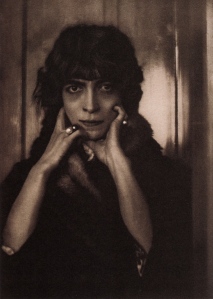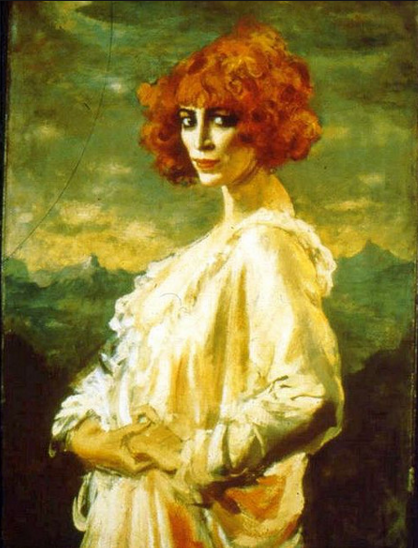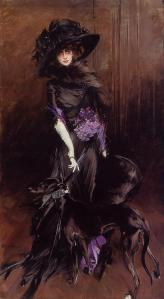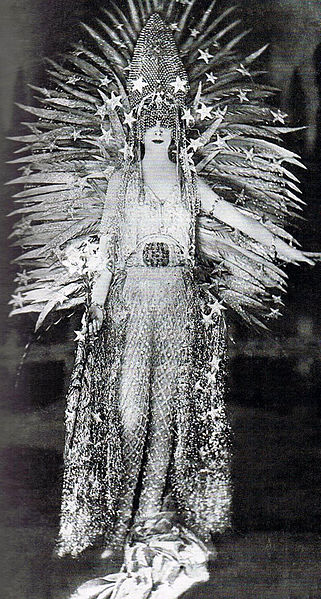 Today, I want to tell you about Luisa Casati, who was born in Milan on this day in 1881. She was famous for being very wealthy, very extravagant and very eccentric. Both her parents had died by the time she was fifteen. This left Luisa and her sister Francesca heiresses to a huge fortune and probably the wealthiest women in Italy. At nineteen, Luisa married Count Camillo Casati Stampa di Soncino. They had one daughter, but never really lived together.
Today, I want to tell you about Luisa Casati, who was born in Milan on this day in 1881. She was famous for being very wealthy, very extravagant and very eccentric. Both her parents had died by the time she was fifteen. This left Luisa and her sister Francesca heiresses to a huge fortune and probably the wealthiest women in Italy. At nineteen, Luisa married Count Camillo Casati Stampa di Soncino. They had one daughter, but never really lived together.
 So Luisa was fabulously wealthy and free to do pretty much what she wanted. What she wanted was to be a living work of art. She was a striking figure, six feet tall and extremely thin. She cut her hair, dyed it bright red, powdered her face deathly white and wore heavy black make-up around her eyes. It was an extremely unusual look at the beginning of the twentieth century. She also wore false eyelashes and put drops of poisonous belladonna into her eyes to dilate the pupils. Luisa was a great patron of the arts and commissioned paintings, photographs and sculptures in many different styles by a wide variety of artists, some famous, some unknown. But she was also a terrible narcissist, so all the works are of Luisa Casati. Luckily, because she was such a wild looking person, artists loved her and she became something of a muse.
So Luisa was fabulously wealthy and free to do pretty much what she wanted. What she wanted was to be a living work of art. She was a striking figure, six feet tall and extremely thin. She cut her hair, dyed it bright red, powdered her face deathly white and wore heavy black make-up around her eyes. It was an extremely unusual look at the beginning of the twentieth century. She also wore false eyelashes and put drops of poisonous belladonna into her eyes to dilate the pupils. Luisa was a great patron of the arts and commissioned paintings, photographs and sculptures in many different styles by a wide variety of artists, some famous, some unknown. But she was also a terrible narcissist, so all the works are of Luisa Casati. Luckily, because she was such a wild looking person, artists loved her and she became something of a muse.
 Everything about her was completely over the top. She had several luxurious residences. In Venice, she occupied the half-ruined Palazzo dei Leoni on the Grand Canal. The gardens were lit by enormous Chinese lanterns and she had pet cheetahs who roamed freely. Luisa had quite a large collection of animals, among them, black parrots, albino blackbirds, which she dyed blue, greyhounds and white peacocks. In Venice, she could often be seen out for an evening walk, with a pair of cheetahs in diamond studded collars, naked save for a fur coat and a string of pearls. She also sometimes wore snakes around her neck, head or arms as living jewellery. At her infamous soirées, she was waited on by naked servants who were covered with gold leaf. She was also inclined to sit wax mannequins at the dinner table which reputedly contained the ashes of her past lovers.
Everything about her was completely over the top. She had several luxurious residences. In Venice, she occupied the half-ruined Palazzo dei Leoni on the Grand Canal. The gardens were lit by enormous Chinese lanterns and she had pet cheetahs who roamed freely. Luisa had quite a large collection of animals, among them, black parrots, albino blackbirds, which she dyed blue, greyhounds and white peacocks. In Venice, she could often be seen out for an evening walk, with a pair of cheetahs in diamond studded collars, naked save for a fur coat and a string of pearls. She also sometimes wore snakes around her neck, head or arms as living jewellery. At her infamous soirées, she was waited on by naked servants who were covered with gold leaf. She was also inclined to sit wax mannequins at the dinner table which reputedly contained the ashes of her past lovers.
At the Palais Rose, a mansion of pink marble just outside Paris, she had a gallery which housed over 130 portraits of herself. The entire west wing of the house was given over to a menagerie of birds and reptiles. There, she also kept a mechanical stuffed panther that we are told could leap and also had flashing lights. Sorry, I couldn’t find a picture, but it sounds awful.
 Summer would find her at the Villa San Michele on the isle of Capri. Even though it was a bit of a haven for bohemians, she still managed to scandalise her neighbours. She paraded through the village wearing a long black gown, with her hair dyed green and carrying a crystal ball. Luisa was terribly interested in the occult and was as happy hosting a black mass as a masqued ball. Her wardrobe, in general was pretty amazing, as you can see from the picture on the left. Her style is still influencing fashion designers today. She once wore a suit of armour, pierced by electrified arrows, which was very dangerous indeed and also appeared at one of her parties in a gown made from white peacock feathers which she accentuated with fresh chicken’s blood.
Summer would find her at the Villa San Michele on the isle of Capri. Even though it was a bit of a haven for bohemians, she still managed to scandalise her neighbours. She paraded through the village wearing a long black gown, with her hair dyed green and carrying a crystal ball. Luisa was terribly interested in the occult and was as happy hosting a black mass as a masqued ball. Her wardrobe, in general was pretty amazing, as you can see from the picture on the left. Her style is still influencing fashion designers today. She once wore a suit of armour, pierced by electrified arrows, which was very dangerous indeed and also appeared at one of her parties in a gown made from white peacock feathers which she accentuated with fresh chicken’s blood.
In the 1930’s she ran out of money and fled to London, in debt to the tune of $25 million dollars. Her property was sold to pay her creditors, so much of her art collection is now lost. She lived in relative poverty for the rest of her life, but seems to have lost none of her splendour and eccentricity. Quentin Crisp recalled meeting her in the 1940s. He met her at a tea party, dressed head to foot in black velvet, mouth painted blood red and carrying a tall umbrella. He said: “She wasn’t beautiful – she was spectacular.” She died in 1957 and was buried at Brompton cemetery, wearing a pair of false eyelashes and with a stuffed Pekinese dog at her feet. On her headstone is a quote from Shakespeare’s ‘Anthony and Cleopatra’: “’Age cannot wither her, nor custom stale her infinite variety.”